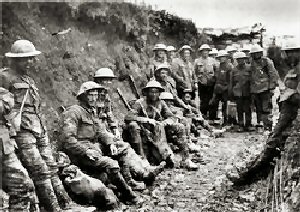I was in
… a battle in which the 16th Irish and 36th Ulster Divisions fought and died side by side during World War 1.
We stayed in the
We stayed in Messines for one week and each day after breakfast I would wander down to the graveyard and go to his grave and talk to him. I told him what Newry was like now and told him about the changes that had taken place in the town since he went away to that ‘war to end all wars.’ I vowed that when I came home I would find out as much about this young Newry soldier as I could. This is what I now know.
On September 2nd 1899 Ann McAlister, wife of John McAlister, gave birth to a son. They named him Bernard. On his birth certificate in the section, ‘Name and Surname and Dwelling-place of Father’ are the words ‘John McAlister. Dwelling place not known.’ The reason for this was simple – the family were residents of Newry Workhouse.
The 1901 Census only gives the initials of those in the workhouse but there was A McA and a J McA. The 1911 Census gave an A McA and a J McA but no B McA so one cannot be sure if they were still there in that year but in 1917, their address was given as
The 1911 Census also showed that another family lived there when the census was taken so sometime after that the McAlisters moved into that address. Indeed, as the householders list in our next story shows [from the Reporter Year Book of 1917] this house was registered to one James Curran then so the McAlisters were home-sharing. Still it might be assumed that this was their first home after the Workhouse, but Bernard did not live there long because just after his seventeenth birthday, either to get away from his poverty or believing the stories he was told about the war, he joined the Royal Irish Rifles.
After his recruitment training, he was sent to
‘Greater love than this no man hath, than a man lays down his life for his friend.’
In Colin Moffett’s well researched book ‘Newry’s War Dead’ his next of kin is given as his mother, Annie McAlister. The British Army will only put number, rank, name and date of death on the gravestones. Anything else must be paid for by the family so one can assume that this inscription was put on and paid for by his mother who must have been very proud of her young son. Bernard was posthumously awarded the Victory Medal and the British War Medal.
There is a poem etched in stone at the 36th Ulster Division,
It was penned by David Starret of the 9th Royal Irish Rifles:
‘So the curtain fell
Over that tortured country
Of unmarked graves and
Unburied fragments of men …
Murder and massacre:
The innocent slaughtered
For the guilty.
The poor man
For the sake of the greed
Of the already rich …
The man of no authority
Made the victim of the man
Who had gathered importance
And wished to keep it.
